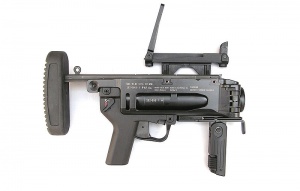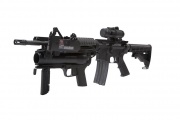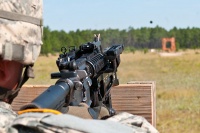M320 grenade launcher
From Gunsopedia
| M320 Grenade Launcher Module | |
|---|---|

| |
| M320 with detachable buttstock | |
|
| |
| Type | Grenade launcher |
| Land of Origin | Germany |
| Specifications | |
| Length | 350 mm (13.7 in.) |
| Barrel length | 280 mm (11 in.) |
| Weight | 1.5 kg (3.3 lb) |
| Cartridge | 40x46mm SR |
| Action | Single shot, double action |
|
| |
| Rate of Fire | 5 to 7 rpm |
| Muzzle velocity | 76 m/s |
| Effective Range | 150 m |
| Max. Range | 400 m |
| Feed | Single shot |
| Production History | |
| Manufacturer | Heckler & Koch |
| Unit Cost | US$3,500 |
The unit was officially fielded in July 2009 at Fort Bragg by the 1st Brigade Combat Team, 82nd Airborne Division.[3]
Contents |
Overview
The M320 has three major parts: a grenade launcher, Day/Night Sight (DNS) produced by Insight Technology, Inc and a hand held Laser Range Finder (LRF). Some of the benefits are:
- The M320 can be used in two ways. It can be attached to the M16 assault rifle and the M4 Carbine, attaching under the barrel forward of the magazine, or it can be used dismounted with a stock attached as a stand alone model.
- The Day/Night Sight allows the grenadier to effectively engage the enemy in the dark.
- The sights on the M320 are located to the side of the launcher. This avoids the problems that the M203 had with its sight design. The M203's sights were mounted on top of the launcher and could interfere with the rifle's sights and they had to be attached separately. This meant two separate operations had to be performed when adding the grenade launcher to the weapon, and since the sights were not integral to the M203, they had to be re-zeroed every time the launcher was reattached to the rifle.
- The M320 can fire all NATO high-explosive, smoke, and illuminating grenades. Its breech opens to the side, allowing it to fire a variety of newer rounds which are longer, in particular certain less-lethal rounds.
- The M320 operates in double action mode, with an ambidextrous safety. In case of misfire, the M320 operator merely has to pull the trigger again. The M203 used a single action mode which cocks the weapon as the barrel is opened. The M203 operator has to open the barrel by unlocking it and pushing forward to cock the weapon and then re-close the barrel, then pull the trigger again. The problem with this is that in opening the barrel, the grenade is designed to eject and the operator must ensure that it does not fall to the ground.
- The LRF helps eliminate range estimation errors common in shots greater than 100 meters, thus increasing first round hit probability.
Resources

This article or section is missing resources, such as diagrams or manual links, and could use more input to fill in the missing bits. You (yes, you!) can help Gunsopedia provide more comprehensive information to our users by using your own knowledge to add to it.
See also
- KAC Masterkey
- M26 Modular Accessory Shotgun System
- Rifle grenade
- Under-slung Grenade Launcher
- Related Lists:
References
- ↑ "XM320 Grenade Launcher Module And XM26 Modular Accessory Shotgun System", Army Magazine
- ↑ " AG36 / AG-C / EGLM / XM320 grenade launcher", Modern Firearms
- ↑ MacLeod, Spc. Michael J. "Bragg GIs 1st to Field Grenade Launcher". Military.com, July 08, 2009
- Fuller, BG Peter N.; COL Douglas A. Tamilio (18 MAY 2010). "Project Manager Soldier Weapons Briefing for NDIA" United States Army.
External links
- AG36 / AG-C / EGLM / XM320 grenade launcher page on Modern Firearms site
- M320 on GlobalSecurity.org
- XM320 page on HK USA site
| Handguns | M9 | M11 | MEU(SOC) | Mk 23 | Mk 24 | |
|---|---|---|
| Rifles | Assault and Battle | M16 | Mk 14 | Mk 17 |
| Carbine | HK416 | M4 | Mk 18 | |
| Designated Marksman | DMR | M14 | M39 | Mk 12 | SAM-R | SDM-R | SEAL Recon Rifle | |
| Sniper | M24 | M40 | M107 | M110 | Mk 11 | Mk 15 | |
| Shotguns | M26 | M590 | M870 | M1014 | |
| Submachine guns | MP5N | P90 | |
| Machine guns | M2HB (still!) | M240B | M249 and Mk 46 | Mk 43 | |
| Grenade launchers | M203 | M32 | M320 | M79 | Mk 19 | Mk 47 | |
| Mortars | M120 | M224 | M252 | |
| Rockets | M3 | M72 series | M136 | M141 | M202A1 | Mk 153 | |
| Missiles | FGM-172 | FGM-148 | FIM-92 | |
| Cartridges | 12-gauge | 5.7x28mm | 9x19mm NATO | .45 ACP | 5.56x45mm NATO | 7.62x51mm NATO | .50 BMG (12.7x99mm NATO) | 40x46mm | |
| This article is part of a series on Heckler & Koch firearms | ||
|---|---|---|
| Handguns | HK4 · VP70 · P9 · P7 · Mark 23 · USP · P2000 · P30 · HK45 |  |
| Military Semi-auto & Select-fire Rifles | G3 · HK33 · PSG1 · G41 · G36 · HK416 · HK417 | |
| Civilian Rifles | HK41 · HK43 · SL6 · SL7 · SL8 · SR9 | |
| Shotguns | FABARM FP6 | |
| Submachine guns | MP5 (duh!) · UMP · MP7 | |
| Machine guns | HK21 · MG4 | |
| Grenade launchers | HK69A1 · AG-C/GLM · AG36 · M320 · GMG | |
| Prototypes | Handguns — P46 Rifles — HK32· HK36· G11· XM29 OICW· XM8 Shotguns — HK CAWS | |
| Other Stuff | P2A1 · P11 · 4.6x30mm | |

